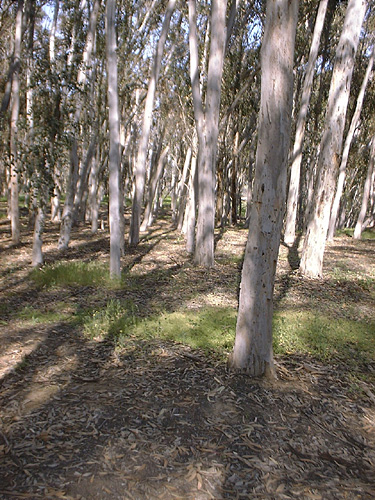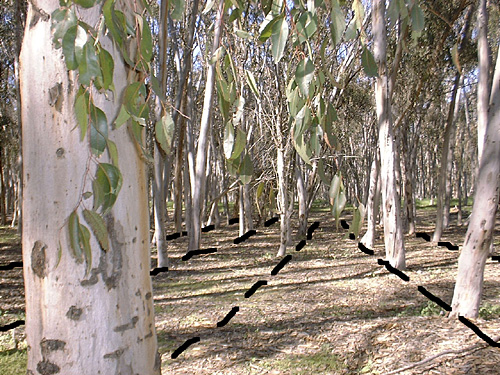
Last time, I wrote about going to the eucalyptus groves at UCSD to look for wildflowers. I’ve always been fascinated with these areas of the campus. Boston ivy growing on brick buildings might define the look of certain East Coast schools, but here it’s the eucalyptus trees.
At first your eye follows the trunks on these trees, in the summer covered with beautiful exfoliating bark, up to the high branches and out to the weeping branches that come back towards earth, often with vivid red coloration on the stems, contrasting with the slender gray-green leaves. Individually the trees are striking, and growing together they give the impression of a light, sunny forest. Pay some attention to how they’re planted, however, and the initial impression of pristine nature falls apart. Below I’ve taken a picture and drawn black lines that accentuate the rigid rows that were used to plant the “forest.” Not so natural after all. Southern California, home of the simulacra manufactured in Hollywood, the fake features of Disneyland, and the artificially buxom women of West-Side L.A., does it again.

You probably know that the trees are native to Australia, and may know that down under they’re sometimes called “widow-makers” because of their tendency to drop their branches onto people. You may even know their history in Southern California, that they were planted by the millions as part of various get-rich schemes in the later 19th and earlier 20th centuries, with promises that they’d grow wood for railroad trestles or ocean piers, or that they’d yield essential oils with all sorts of miraculous properties. A great article in the Journal of San Diego History goes into some of their fascinating past.
The plantings that remain throughout Southern California are beautiful stands. The occasional grove even harbors monarch butterflies on the migrations. (An area of the UCSD groves used to be alive with monarchs during the winter in the earlier 1980s, but I haven’t seen more than the occasional monarch since then. Too bad, for sure.) But these groves of perfectly-aligned trees for me talk about culture and nature, and of the ways accidents of history shape how the world looks today.

2 thoughts on “a fake forest”